Weekly Current Affairs (1st to 7th August 2024) Part - 1 | General Test Preparation for CUET UG - CUET Commerce PDF Download
GS3/Environment
The State of the World's Mangroves 2024
Why in news?
- Recently, a report titled "The State of the World's Mangroves 2024" was released by the Global Mangrove Alliance (GMA) on World Mangrove Day (26 July). The GMA is the preeminent alliance of 100-plus members driving the conservation and restoration for the world’s mangroves.
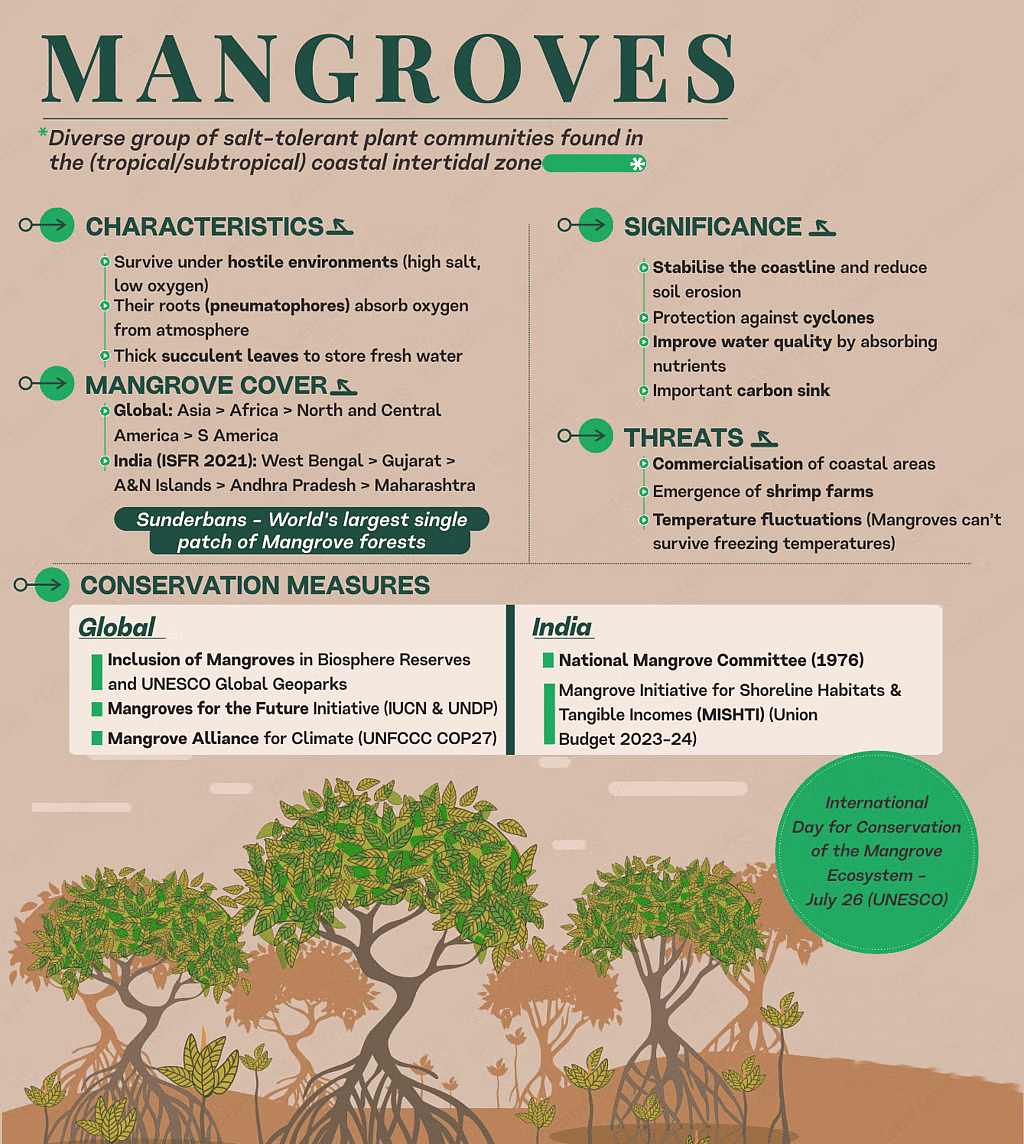
Key Benefits of the Mangroves as Per the State of the World's Mangroves 2024 Report
About:
The latest world map (GMW v4.0), developed by the Global Mangrove Watch, provides a sixfold improvement in spatial resolution. It maps 147,256 km² of mangroves in 2020, adding data for six new territories. Southeast Asia holds about one-third of the world's mangroves, with Indonesia alone accounting for 21%.
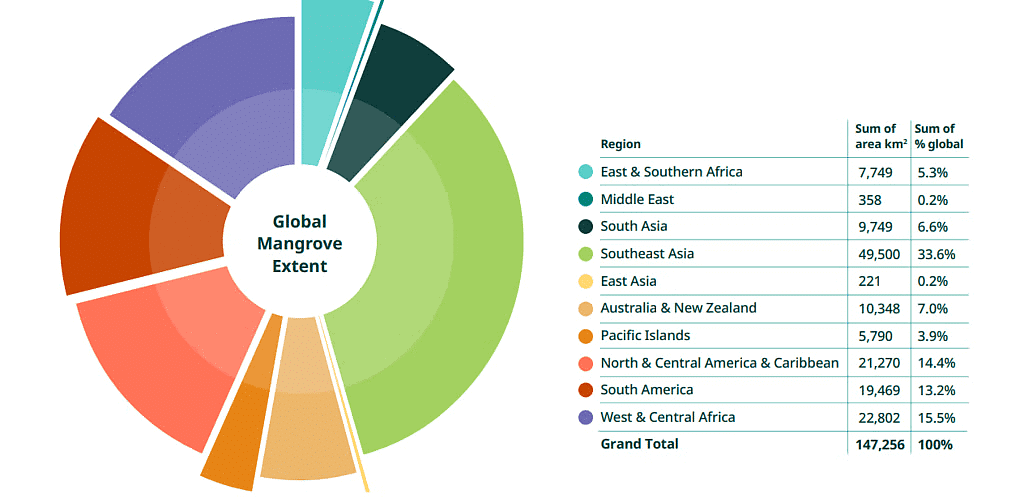
Key Benefits of Mangroves
Carbon Storage:
- Mangroves hold, on average, a remarkable 394 tonnes of carbon per hectare in their living biomass and in the top meter of soil. Some mangrove areas, like in the Philippines, have average values of over 650 tonnes of carbon per hectare.
Biodiversity:
- Mangroves are home to a tremendous diversity of species, reflecting their ecotone nature. Over 5,700 plant and animal species, across 21 phyla, have been recorded in Indian mangroves alone.
Flood Reduction:
- Flooding is the most frequently occurring natural disaster worldwide and is exacerbated by climate change. Mangroves can reduce flood depths by 15-20%, and over 70% in some areas.
Food Security:
- Mangroves support nearly 800 billion young fish, prawns, bivalves, and crabs annually, crucial for global fisheries. They provide non-aquatic food resources like honey, leaves, and fruits, essential for local communities.
Cultural Significance:
- Mangrove species are widely used in traditional medicine, providing health benefits to local populations.

What are the Key Highlights in the Report Regarding India?
Mangrove Cover in India:
- In India, West Bengal holds the largest mangrove area followed by Gujarat, majorly located in the Gulf of Kutch and Gulf of Khambhat.
Biodiversity in the Mangrove Ecosystems of India:
- Mangrove ecosystems of India have perhaps the highest record of biodiversity of any country, with a total of 5,746 species. Of these, 4,822 species (84%) are animals.
Critically Endangered and Vulnerable Mangroves:
- Natural mangrove forests on the southern Indian coast are critically endangered, particularly in the Lakshadweep archipelago and Tamil Nadu, due to rising sea levels from global warming.
- The report identifies shrimp aquaculture as a major driver of mangrove loss, highlighting its expansion in states like Andhra Pradesh, West Bengal, and Gujarat.
- Mangroves on the western coast, extending from Gujarat to Kerala, are vulnerable to collapse due to human activities and natural threats such as tropical storms.
- Conservation challenges in the Gulf of Cambay (Khambhat) include severe grazing and lopping during the flowering season, which hinders natural regeneration and damages the mangrove stock.
Government Initiatives:
- The Union government has launched the Mangrove Initiative for Shoreline Habitats & Tangible Incomes (MISHTI) programme to augment mangrove cover by planting mangroves in 540 sq km across 11 states and two Union territories. Corporate involvement includes six major corporations signing MoUs with the Gujarat forest department to plant mangroves in 30 sq km.
What are the Challenges Highlighted in the Report?
- Conversion to aquaculture (26%), oil palm plantations, and rice cultivation together explain 43% of mangrove losses between 2000 and 2020.
- Logging for timber and charcoal production leads to significant mangrove degradation.
- Natural retraction, influenced by sediment shifts, and sea-level rise, also impacted 26% of mangrove areas.
- Increasing sea levels threaten mangrove habitats, especially those with limited freshwater and sediment input.
- More frequent and intense cyclonic storms cause significant damage to mangrove ecosystems.
- Despite efforts, only 40% of the world's remaining mangrove forests are in protected areas.
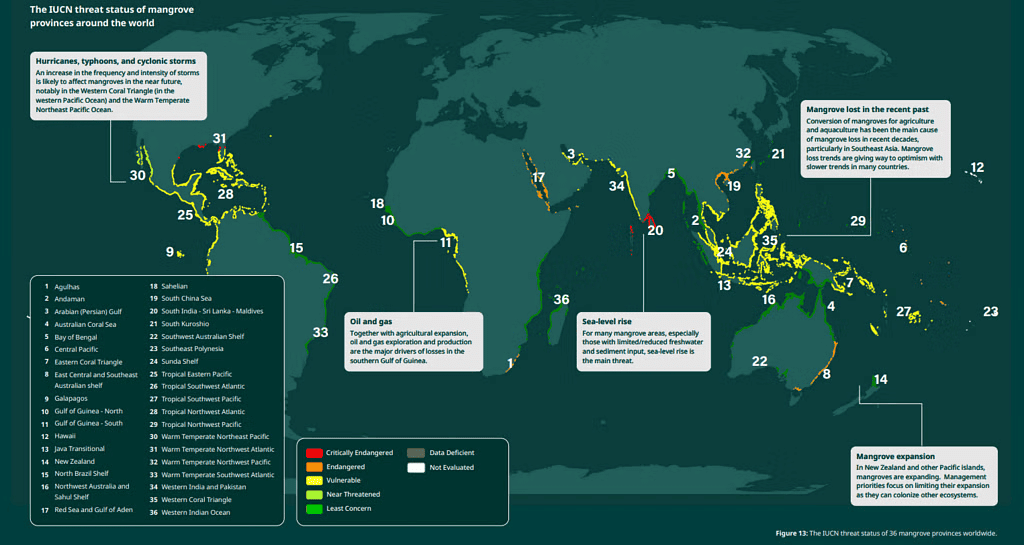
What are the Steps Suggested in the Report for the Protection of Mangroves?
Six Guiding Principles for Successful Mangrove Restoration:
- Safeguard nature and maximise biodiversity, enhance resilience, and implement science-based ecological restoration protocols.
- Employ the best available science-based knowledge for mangrove interventions, including successful community-led restoration projects.
- Implement social safeguards that operate locally to protect and enhance community member rights.
- Operate in the local context, aligning with cultural customs and ownership regimes.
- Create sustainable mangrove projects and programs that consider financing, threat abatement, and climate change.
- Ensure capital flows for funding conservation actions, including innovative financial tools like carbon credits and mangrove insurance.
- Expand Protected Areas: The Global Mangrove Alliance aims to halt mangrove loss, restore lost mangroves, and double protection by 2030.
- Increase the percentage of mangrove areas under legal protection. The Global Mangrove Alliance aims to double the protection to 80% by 2030.
- Implement Other Effective Area-Based Conservation Measures (OECMs) that integrate biodiversity into sectors like food and water security.

Mains Question:
Q. Discuss the current state of mangrove forests in India. What are the major challenges faced by these ecosystems, and what measures can be taken to address them?
GS3/Science and Technology
Genetic Testing in Sports
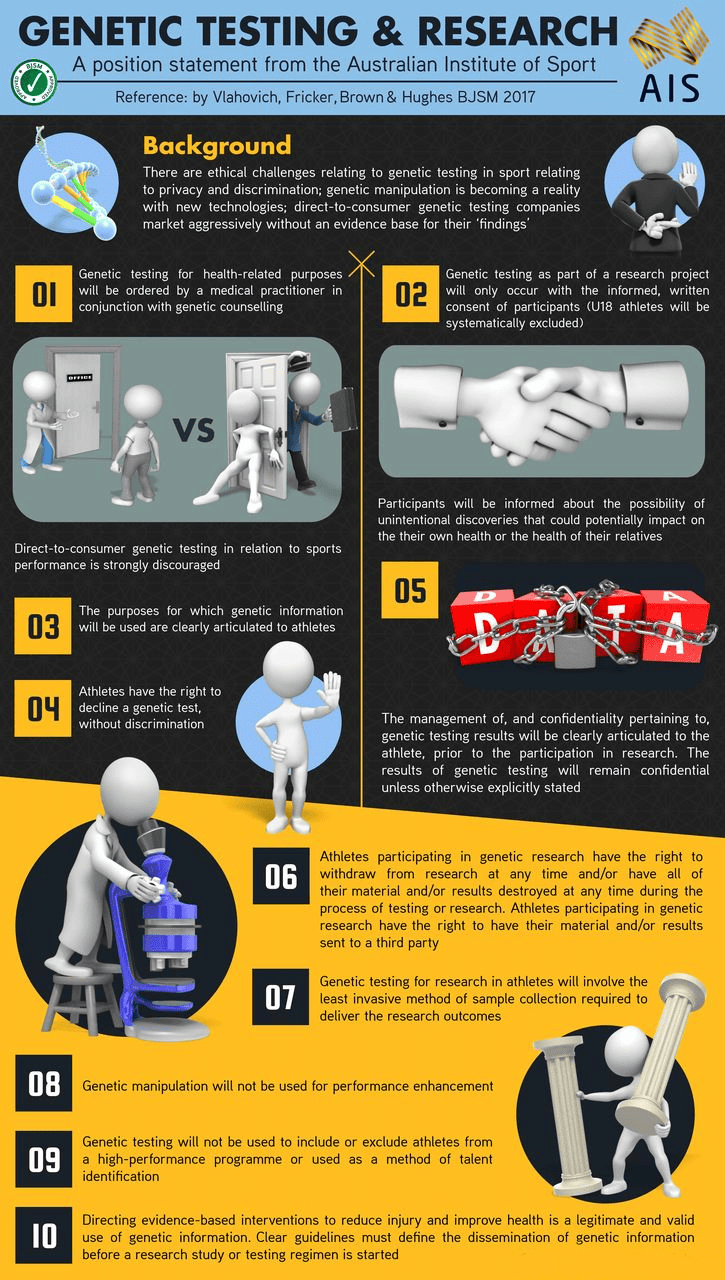
Why in News?
- The emergence of genetic testing in sports has gained significant attention, especially with athletes utilizing it for performance enhancement ahead of the 2024 Paris Olympics. This trend has sparked debates about the potential benefits and ethical concerns surrounding athletic genetic screening.
What is Genetic Testing?
About:Genetic testing involves analyzing an individual's DNA to identify genetic variants that can influence health, traits, and performance. It detects alterations in chromosomes, genes, or proteins to confirm or exclude genetic conditions and assess the likelihood of developing or transmitting genetic disorders. These tests can be conducted using samples from blood, hair, skin, amniotic fluid, or other tissues.
Types:
- Cytogenetic Testing: Examines whole chromosomes.
- Biochemical Testing: Measures proteins produced by genes.
- Molecular Testing: It detects small DNA mutations.
Applications:
- Newborn Screening and Diagnostic Testing: Genetic testing can be conducted just after birth to identify treatable genetic disorders. It can be used to confirm or rule out specific genetic conditions based on physical signs and symptoms.
- Carrier Testing: It identifies individuals carrying one copy of a gene mutation that could cause a genetic disorder if present in two copies. Useful for those with a family history of genetic disorders or belonging to certain high-risk ethnic groups.
- Preimplantation Testing (PGD): It can be used in conjunction with in-vitro fertilization to test embryos for genetic changes before implantation, reducing the risk of genetic disorders.
- Forensic Testing: It utilizes DNA sequences for legal purposes, such as identifying crime victims, suspects, or establishing biological relationships.
How is Genetic Testing Used to Improve Athlete's Performance?
- Identification of Genetic Markers: Genetic testing can reveal specific markers associated with physical traits that contribute to athletic performance. For example, variations in genes like ACE (angiotensin-converting enzyme) and ACTN3 (alpha-actinin 3) have been linked to endurance and strength capabilities, respectively.
- Assessment of Muscle Fiber Composition: Genes influence the proportion of fast-twitch muscle fibers, which are crucial for explosive strength and sprinting. Athletes with certain variants of this gene may be predisposed to excel in power sports, while others may have a genetic makeup favoring endurance activities.
- Evaluation of Recovery and Injury Risk: Genetic testing can identify predispositions to injuries or recovery times. For instance, variations in genes related to collagen production can indicate susceptibility to tendon and ligament injuries, allowing for tailored training and preventive strategies.
- Nutritional Needs and Metabolism: Genetic insights can help determine how well an athlete metabolizes nutrients. For example, identifying lactose intolerance or variations in vitamin D metabolism can guide dietary choices that optimize performance and overall health.
- Psychological Traits: Certain genetic variants may influence psychological traits such as motivation, stress response, and pain tolerance, which are critical for competitive success. Understanding these traits can help in mental conditioning and preparation.
- Tailored Training Programs: By understanding an athlete's genetic predispositions, coaches can design training regimens that align with their strengths and weaknesses, enhancing performance potential.
What are the Limitations of Genetic Testing?
- Scientific Uncertainty: The relationship between genetics and athletic performance is complex and not fully understood. Many studies yield conflicting results, making it difficult to draw definitive conclusions.
- Small Sample Sizes: Many genetic studies involve limited sample sizes, which can affect the reliability and generalizability of findings across different populations and sports.
- Overemphasis on Genetics: Focusing too much on genetic factors can overshadow the importance of training, practice, nutrition, and psychological aspects, which are crucial for athletic success.
- Ethical Concerns: Issues related to privacy, potential discrimination, and misuse of genetic information pose significant ethical challenges for athletes.
- Misinterpretation of Data: Genetic data can be complex and may be misinterpreted without expert guidance, leading to incorrect conclusions about an athlete's potential.
- Commercial Exploitation: The rise of direct-to-consumer genetic testing often prioritizes profit over scientific validity, raising concerns about the accuracy of results and the motivations behind testing.
Way Forward
- Independent Research: Encourage comprehensive studies by independent scientific bodies to validate findings on genetic influences and understand gene interactions better.
- Education and Training: Provide training for coaches and nutritionists to accurately interpret genetic data and apply it effectively in athlete development.
- Ethical Guidelines: Develop clear ethical guidelines to protect athletes' privacy and prevent discrimination based on genetic information, ensuring responsible use of data.
- Holistic Approach: Emphasize a balanced approach that integrates genetic insights with traditional training, nutrition, and psychological support, recognizing the interplay of genetics and environment.
- Collaboration with Regulatory Bodies: Work with sports organizations to create policies governing the use of genetic testing, ensuring fairness and standardization in practices.
- Public Awareness Campaigns: Conduct campaigns to educate athletes and the public about the benefits and limitations of genetic testing, promoting informed decision-making.
Conclusion
While genetic testing can provide valuable insights into athletic potential, it is crucial to combine these findings with environmental factors, training, and personal dedication to fully realize an athlete's capabilities.
GS3/International Relations
IPEF Elects India as Vice-Chair of Supply Chain Council
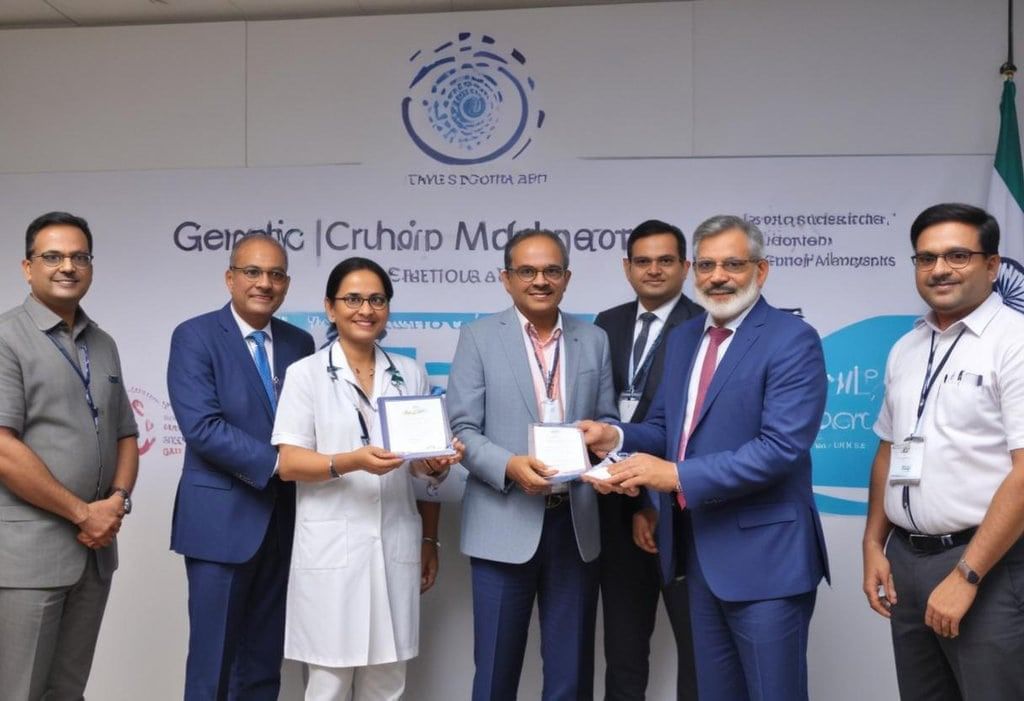 Why in News?
Why in News?
- India has recently been chosen as the Vice-Chair of the Supply Chain Council, one of the three bodies formed by the 14-member Indo-Pacific Economic Framework (IPEF) bloc.
What is the Supply Chain Council?
About:
- Establishment: India and 13 other partners have created three supply chain bodies under the Indo-Pacific Economic Framework for Prosperity Agreement pertaining to Supply Chain Resilience.
Supply Chain Council:
- Mandate: The council is dedicated to conducting targeted, action-oriented efforts to fortify the supply chains critical to national security, public health, and economic well-being.
Crisis Response Network:
- Purpose: It serves as a platform for a collective emergency response to immediate disruptions.
Labor Rights Advisory Board:
- Objective: This board brings together workers, employers, and governments to enhance labor rights and workforce development across regional supply chains.
Recent Appointments:
- Selection Process: Each of the three supply chain bodies elected a Chair and Vice Chair during the meetings for a two-year term.
Significance:
- Cooperation: The virtual meetings of the Supply Chain Council, Crisis Response Network, and Labor Rights Advisory Board signify a significant step towards collaboration among partner countries to bolster supply chain resilience.
Supply Chain Council Initiatives:
- Progress: The council adopted Terms of Reference and discussed initial work priorities, to be further explored in its first in-person meeting planned in Washington in September 2024.
Crisis Response Network Activities:
- Plans: The network discussed immediate and long-term priorities, including organizing a tabletop exercise, and scheduled its inaugural in-person meeting alongside the Supply Chain Summit.
Labor Rights Advisory Board Focus:
- Agenda: The board deliberated on priorities to enhance labor rights across IPEF supply chains, emphasizing the labor provisions in the IPEF Clean Economy Agreement and Fair Economy Agreement.
GS3/Environment
Oil Drilling in Assam’s Hoollongapar Gibbon Sanctuary
Why in News?
- The Union Environment Ministry’s recent approval for exploratory oil and gas drilling in Assam’s eco-sensitive zones has raised concerns about the potential threat to the endangered hoolock gibbons. Cairn India, the oil and gas unit of Vedanta Ltd, seeks to use 4.4998 hectares of reserved forest land for exploration in the eco-sensitive zone of the Hoollongapar Gibbon Wildlife Sanctuary.
How Will Oil and Gas Drilling Impact the Hoolock Gibbon?
Endangered Species at Risk:
- The hoolock gibbon, a canopy dweller, is highly sensitive to habitat fragmentation. Any disruption, even minor, can severely impact their movement and survival.
Presence of Multiple Species:
- The area proposed for exploration is home to elephants, leopards, and hoolock gibbons, highlighting the rich biodiversity at stake.
- The are concerns raised that oil drilling could exacerbate human-wildlife conflicts and disrupt these species' habitats.
Past Incidents:
- The Baghjan blow-out (2020) in Assam which caused extensive ecological damage, serves as a cautionary example of the risks associated with oil and gas exploration in sensitive areas.
What are the Key Facts About the Hoolock Gibbon?
About:
- Gibbons, the smallest and fastest apes, live in Asia's tropical and subtropical forests. The hoolock gibbon, unique to India's northeast, is one of 20 gibbon species with an estimated population of 12,000.
- All 20 gibbon species are at high risk of extinction due to declining populations and distribution since 1900.
- The hoolock gibbon faces threats primarily from deforestation for infrastructure projects.
Gibbon Species in India:
- Two distinct hoolock gibbon species are found in India's northeastern region: the eastern hoolock gibbon (Hoolock leuconedys) and the western hoolock gibbon (Hoolock hoolock).
- A study by Hyderabad-based Centre for Cellular and Molecular Biology (CCMB) in 2021 proved through genetic analysis that there is only one species of ape in India, debunking earlier research that the eastern hoolock gibbon was a separate species.
- The study concluded that the two populations diverged 1.48 million years ago, while gibbons separated from a common ancestor 8.38 million years ago.
- However, the IUCN Red List categorises the western hoolock gibbon as endangered and the eastern hoolock gibbon as vulnerable.
Conservation:
- In India, the species is protected under Schedule 1 of the Indian (Wildlife) Protection Act 1972.
- The Government of Assam upgraded the Hoollongapar Reserve Forest to a Gibbon Wildlife Sanctuary in 1997, the first protected area dedicated to a primate species.
What are the Key Facts About the Hoollongapar Gibbon Wildlife Sanctuary?
- The Hoollongapar Gibbon Wildlife Sanctuary, established and renamed in 1997, is a crucial protected area in Assam, India.
- Renamed from the Gibbon Wildlife Sanctuary or Hollongapar Reserve Forest in 2004, this sanctuary is renowned for its unique biodiversity, particularly its status as the sole habitat for gibbons in India.
Flora:
- Upper Canopy is dominated by the Hollong tree (Dipterocarpus macrocarpus), which grows up to 30 metres tall, along with species like Sam, Amari, Sopas, Bhelu, Udal, and Hingori.
- The Middle Canopy is characterised by the Nahar tree.
- Lower Canopy features a variety of evergreen shrubs and herbs.
Fauna:
- Hoolock Gibbons and Bengal Slow Loris, the only nocturnal primate in Northeastern India.
Other Primates:
- Stump-tailed macaque, northern pig-tailed macaque, eastern Assamese macaque, rhesus macaque, and capped langur.
Mammals:
- Indian elephants, tigers, leopards, jungle cats, wild boar, and various civets, squirrels, and other mammals.
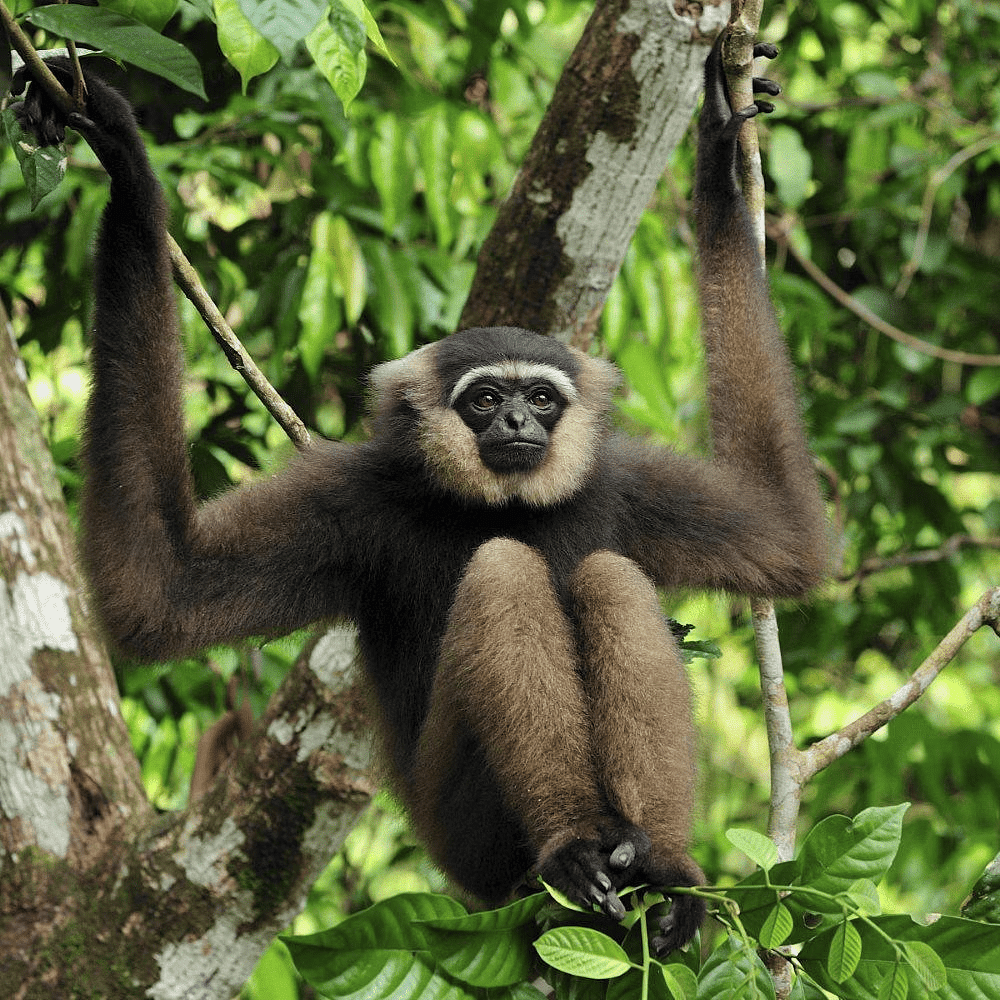
Mains Question:
Q. How does human-wildlife conflict manifest in areas where industrial activities encroach on natural habitats?
GS3/Economy
Sovereign Gold Bond Scheme
 Why in news?
Why in news?
- Recently, the Union Government in the Budget 2024-25 announced a reduction of the import duty on gold from 15% to 6%. Also, the government intends to finalise its decision on the future of the Sovereign Gold Bonds (SGB).
What is the Sovereign Gold Bond Scheme?
Launch:
- The SGB scheme was introduced in November 2015 with the aim of decreasing the demand for physical gold and redirecting a portion of domestic savings, which would otherwise be used to buy gold, into financial savings.
Issuance:
- These bonds are issued as Government of India Stock under the Government Securities (GS) Act, 2006. They are issued by the Reserve Bank of India (RBI) on behalf of the Government of India.
- They are available for purchase through Scheduled Commercial banks, Stock Holding Corporation of India Limited, Clearing Corporation of India Limited, designated post offices, National Stock Exchange of India Limited, and Bombay Stock Exchange Limited, either directly or through agents.
Eligibility:
- The bonds are available for purchase by resident individuals, Hindu Undivided Families (HUFs), trusts, universities, and charitable institutions.
Features:
- Issue Price: The price of gold bonds is linked to the price of gold of 999 purity (24 carats) as published by the India Bullion and Jewellers Association (IBJA), Mumbai.
- Investment Limit: Gold bonds can be bought in multiples of one unit (1 gram), up to specific limits for different investors.
Retail (individual) investors and Hindu Undivided Family (HUF) have a maximum limit of 4 kilograms (4,000 units) per financial year, while trusts and similar entities have a limit of 20 kilograms per financial year. The minimum investment permitted is 1 gram of gold.
- Term: Gold bonds have a maturity period of eight years, with the option to exit the investment after the first five years.
- Interest Rate:
The scheme offers a fixed annual interest rate of 2.5%, payable semi-annually. The interest earned on Gold Bonds is taxable according to the Income Tax Act, 1961.
- Benefit: SGBs can be used as collateral for loans. Capital gains tax on redemption of SGB for individuals has been exempted.
Redemption refers to the issuer repurchasing a bond at or before maturity. Capital gain is the profit earned when the selling price of an asset exceeds its purchase price.
- Disadvantages of Investing in SGB: This is a long-term investment, unlike physical gold, which can be sold immediately. Although SGBs are listed on exchanges, the trading volumes are relatively low, making it challenging to exit before maturity.
GS3/Environment
Nicobar Port Plan From No-Go Zone to Permitted Area
Why in news?
- The Great Nicobar ‘Holistic Development’ Project, spearheaded by the NITI Aayog (National Institution for Transforming India) has stirred considerable debate. Initially flagged for potentially falling within a no-go zone, the project has now been deemed permissible by a high-powered committee (HPC) appointed by the Green Tribunal (NGT).
What is the Great Nicobar ‘Holistic Development’ Project?
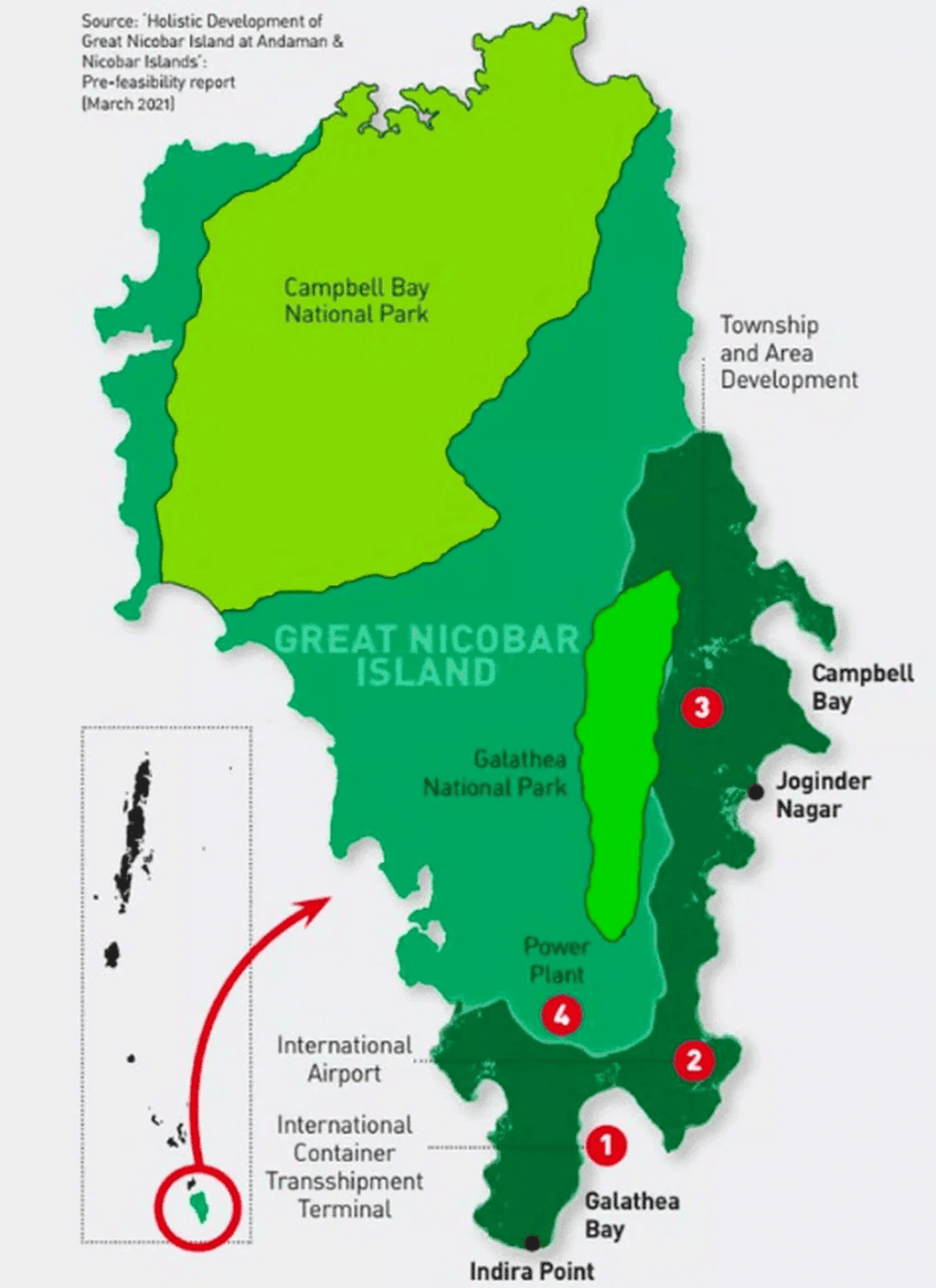
Project Overview
- Launched in 2021, the Great Nicobar Island (GNI) project is a mega infrastructure initiative aimed at transforming the southern end of the Andaman and Nicobar islands.
Components
- Trans-shipment Port: International Container Trans-shipment Terminal (ICTT) expected to bolster regional and global maritime economy.
- Greenfield International Airport: Facilitating global connectivity.
- Township Development: New urban development that may include a Special Economic Zone.
- Power Plant: A 450 MVA gas and solar-based power plant.
- Strategic Location: Positioned near the Malacca Strait, a key maritime route connecting the Indian Ocean to the Pacific Ocean. The project aims to facilitate the deployment of additional military forces, larger warships, aircraft, missile batteries, and troops.
Project Impact on Environment
Deforestation:
- The project will involve the felling of approximately 8.5 lakh trees in the rich rainforests of Great Nicobar.
Wildlife Displacement:
- The de-notification of the Galathea Bay Wildlife Sanctuary and the declaration of a "zero extent" eco-sensitive zone for Galathea National Park threaten critical habitats.
Ecological Destruction:
- Home to unique and threatened tropical evergreen forest ecosystems, the construction may cause irreversible damage to the island’s biodiversity, including endemic species like the Nicobar Megapode and leatherback turtles.
Biodiversity Protection:
- The project contradicts India's commitments under the Convention for Biological Diversity to halt and reverse biodiversity loss by 2030 and protect areas of high ecological importance.
Concerns of the Local Tribes:
- Shompen Nicobarese tribes, primary inhabitants of the island, face significant displacement and cultural disruption.
- Despite claims of protecting tribal interests, local communities have not received adequate responses to their concerns and requests for relocation.
- Local communities withdrew their consent for the project in November 2022, which is necessary for its implementation as the land is part of the tribal reserve.
Technical and Legal Issues
Seismic Risks:
- Great Nicobar rests on a major fault line and is prone to earthquakes and tsunamis. There has been no comprehensive risk assessment conducted for these natural hazards.
Inadequate Reports:
- Environmental Impact Assessment (EIA) report lacks compliance with several Terms of Reference and fails to address critical environmental and social impacts.
Legal Challenges:
- Many approvals and exemptions granted under various laws protecting forests, tribal rights, and coastal ecosystems could face legal challenges in courts and tribunals.
Why was the Project Previously Flagged in a No-Go Zone?
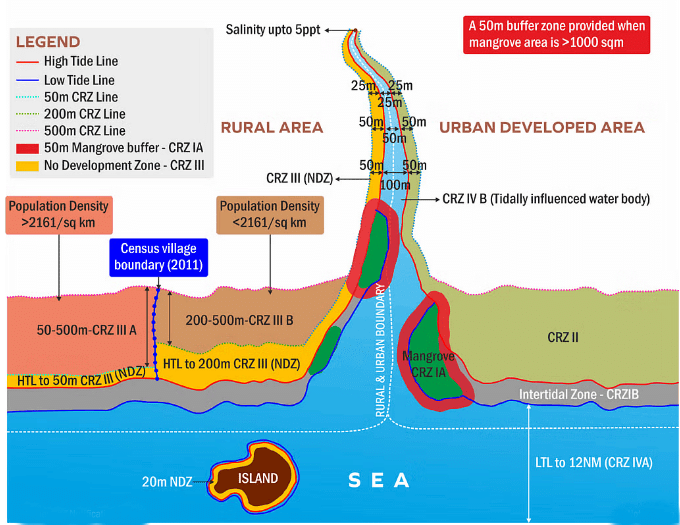
Initial Information: Andaman & Nicobar Coastal Management Authority stated that the port, airport, and township spanned 7 sq km in the Island Coastal Regulation Zone-IA (ICRZ-IA), where port activities are prohibited.
What led to the Reclassification to a Permitted Area?
High-Powered Committee (HPC) appointed by the National Green Tribunal (NGT) concluded that no part of the project falls in the ICRZ-IA area based on a "ground-truthing exercise" National Centre for Sustainable Coastal Management (NCSCM).
HPC’s Conclusions and Recommendations
Coral Colonies:
- The HPC agreed with the Zoological Survey of India's recommendation to translocate 16,150 out of 20,668 coral colonies. Continuous observation of sedimentation for the remaining 4,518 colonies was recommended.
Baseline Data Collection:
- The HPC determined that one-season baseline data collection (excluding the monsoon season) was adequate for assessing the environmental impact of the project, as per the EIA notification, 2006.
Environmental Compliance:
- The HPC’s findings were submitted to the NGT bench by the Andaman and Nicobar Islands Integrated Development Corporation (ANIIDCO). ANIIDCO assured that no activity is proposed within the ICRZ-IA area, in line with specific and general conditions of the environmental clearance. ANIIDCO did not disclose the minutes of HPC’s meetings, citing the project's defence and strategic nature.
What are the Stakeholders’ Responses to the Project?
NGT’s Role:
- A special bench of the NGT formed the HPC to revisit the project’s environmental clearance, addressing concerns raised by environmentalists.
Activist’s Plea:
- Environmental activists filed a plea seeking the exclusion of the project’s activities from ICRZ-IA and disclosure of HPC’s recommendations and meeting minutes.
Government Response:
- The Andaman & Nicobar administration has yet to respond to queries regarding changes in the project’s siting and differing information about its extent in ICRZ areas.
Political and Public Outcry:
- Political leaders questioned the change in land categorization and demanded transparency regarding the new information that led to this change. There are demands for a thorough impartial review of the proposed projects, including by concerned Parliamentary committees.
Way Forward
- A comprehensive and transparent EIA should be conducted by an independent body to assess the project's full environmental and social implications.
- Effective measures to minimize the project's environmental impact, such as habitat restoration, carbon offsetting, and wildlife conservation, should be implemented.
- A participatory approach involving the Shompen and Nicobarese tribes is essential.
- Fair and equitable resettlement plans should be developed.
- Regular public consultations and disclosure of project information are crucial to building trust.
- Explore alternative development models that prioritize sustainability and minimize environmental impact.
- Establish a robust monitoring system to track the project's environmental and social impacts.
Mains Question:
Q. Analyze the objectives of the Great Nicobar Project and its environmental impacts on biodiversity and ecosystems, and propose mitigation measures. Read more: Reimagining Andaman and Nicobar Islands
|
164 videos|628 docs|1133 tests
|





















